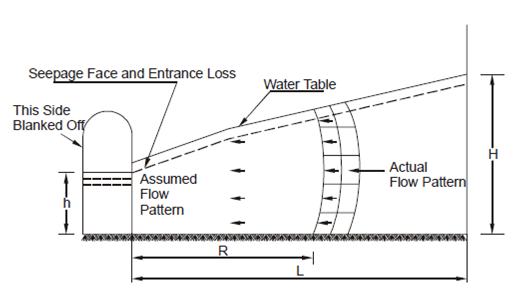Infiltration Galleries:
The ground water travels towards lakes, rivers or streams. This traveling water can be intercepted by digging trench or by constructing a tunnel with holes on sides at right angles to the direction of flow of the ground water. These underground tunnels used for tapping underground water are called infiltration galleries. The yield from infiltration galleries varies with its length depending upon the ground condition. For maximum yield, galleries should be placed at the full depth of the aquifer. Infiltration galleries may be constructed with masonry or concrete with deep holes of 5 cm × 10 cm.
Infiltration galleries are surrounded on the sides and top with gravel or pebbles to increase their intake capacity. Longitudinal slope is given to the galleries and at the end a sump-well is constructed from which water is pumped out. The rate of flow of ground water into infiltration gallery is given by:
Q = KL( H2 - h2/2R)
where, Q = Rate of flow in m3/d,
K = Permeability constant in m/d,
L = Length of the gallery in meter,
H = Initial depth of water level in meter,
h = Final depth of water level in meter, and
R = Radius of influence in meter.
Figure shows cross-section of an infiltration gallery.

Figure : Infiltration Gallery under Equilibrium Condition